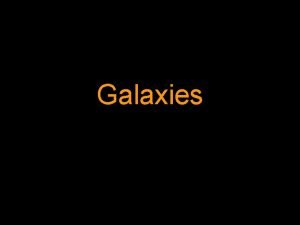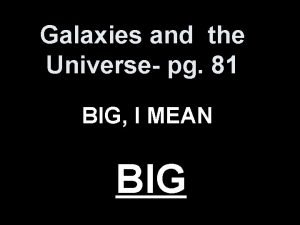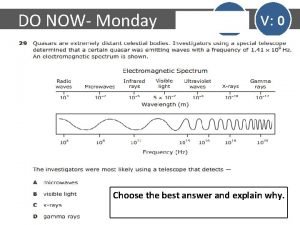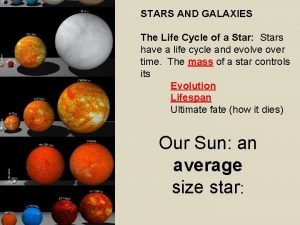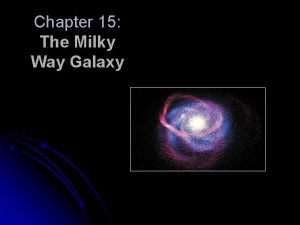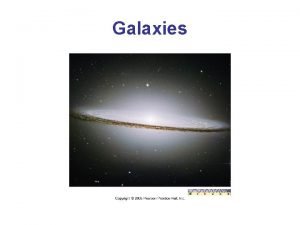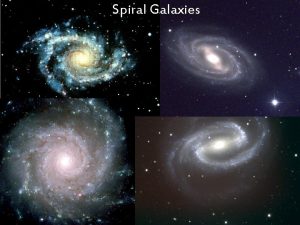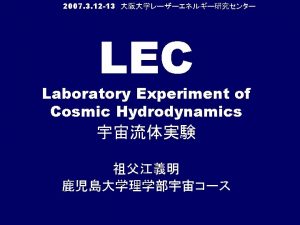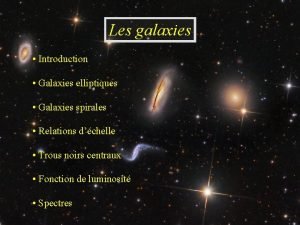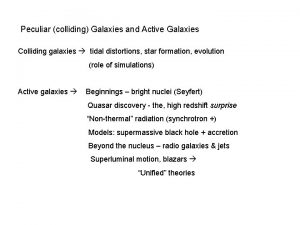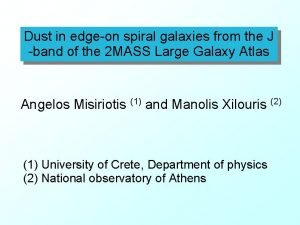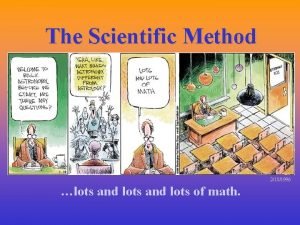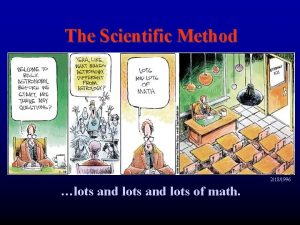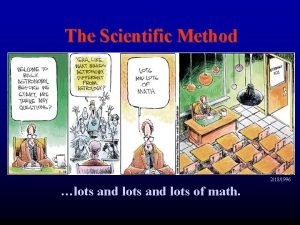Dust Lots of dust in spiral galaxies Dust























- Slides: 23

Dust • Lots of dust in spiral galaxies • Dust absorbs and scatters short wavelength light – The color of objects is reddened if we look through thin dust clouds – Dust clouds look blue • You can peek through dust in near infrared light Dust cloud • • The disk The bulge The nucleus The halo – Globular clusters

Dust • Dust is warmed by absorbing light from stars • It glows in the infrared • • The disk The bulge The nucleus The halo – Globular clusters

A Reflection Nebula – the Pleiades • • The disk The bulge The nucleus The halo – Globular clusters

A Reflection Nebula – the Merope Nebula • • The disk The bulge The nucleus The halo – Globular clusters

Reflection Nebulae IC 349 Witch Head Nebula

Spiral Arms • • The disk The bulge The nucleus The halo – Globular clusters

Spiral Arms – Signs of Rotation • • The disk The bulge The nucleus The halo – Globular clusters • Disk - rotation vs. gravity • Spiral arms - what causes them? – Simple winding? No! – Density waves? Yes! Complicated!

Simple Winding – The Wrong Theory • Spiral arms wind up in one cycle • 20 cycles since beginning of galaxy • Something else is going on Q. 90: Problem With the Winding Theory

An Analogy from Driving • Knot in traffic causes slowdown • Slowdown causes other cars to slow down • Knot in traffic moves • Different cars at different times

Density Waves – The explanation • Gas is in a disk • Inevitably, some parts are more dense than others • Gravity/rotation causes dense parts to become denser – Different gas goes in/out – Dense parts form new/bright stars

The Bulge • Our view of it is (mostly) blocked by dust • We can see through the dust in near infrared • • The disk The bulge The nucleus The halo – Globular clusters

The Bulge The Sun • Flattened sphere approximately 20 kly across • Composition – Mostly older stars – Little gas and dust • Recent evidence indicates it is bar shaped, with left side closer to us than right side. • • The disk The bulge The nucleus The halo – Globular clusters

The Bulge – Color and Appearance • Older stars give it a redder appearance

The Nucleus The Sun • At the center of our galaxy lies a complex region – Fast star formation – Recent supernovae remnants – Hot gas – Fast motion • Density of stars is very high here • Intense radio sources can penetrate the gas and dust • • The disk The bulge The nucleus The halo – Globular clusters

The Nucleus in Radio • Close in, we see streamers of gas apparently flowing in • At the heart is an intense radio source called Sagittarius A*

What is That Thing in the Nucleus? • Copious quantities of X-rays close in • Stars orbit this source very quickly – Kepler’s Laws tell us mass X-ray image • It appears to be a 4 million solar mass black hole Q. 91: Who Says It’s a Black Hole?

The Monster in the Middle • Radio waves can’t come from black hole itself • Gas from nearby attracted by gravity • Accelerates to near light speed • Friction creates heat/X-rays/etc. • More efficient than any other power source • Black hole – 4. 0 million MSun • • The disk The bulge The nucleus The halo – Globular clusters

The Halo • Roughly spherical shape • At least 2 size of disk • Stars: – Old stars (about 10 Gyr) – Orbits well out of plane • Globular Clusters – Up to a million stars each – Oldest stars (up to about 13 Gyr) • Little gas or dust • • The disk The bulge The nucleus The halo – Globular clusters

Total Mass in the Galaxy • Total of a few hundred billion stars • Total mass about 100 billion MSun • Stars mostly concentrated near center • Treat gravity as if it all comes from a point source in the center • Use Kepler’s Third law: MP 2 = a 3 Object Disk Stars Disk Gas Bulge Halo Stars Nucleus Mass (MSun ) 60 billion ~10 billiion 20 billion 1 billion 4 million Q. 92: Rotation Curves for Galaxies

Where is the Mass? • Measure rotational velocities using Doppler shift of 21 cm line • Plot vs. distance from center of galaxy

Dark Matter • 85% of mass is not concentrated in the center • It does not glow, it is dark • We do not know what it is • We know a lot of things it isn’t: – Living Stars – Gas – Dust • Could it be MACHOs? What is the dark matter? A) Neutron Stars B) Black Holes C) White Dwarfs D) Planets without stars E) Something else • • The disk The bulge The nucleus The halo – Globular clusters Massive Compact Halo Objects

MACHOs How to catch a MACHOs Neutron Stars Black Holes White Dwarfs Planets without stars • All of these objects are dark • But they do have gravity! • Einstein says they can bend light • They can magnify a distant star MACHO: We see:

MACHO’s: What the Data Tells Us • MACHO’s do exist • Substantial fraction of stars – But not the majority • There are not enough of them to account for the dark matter • They are probably mostly white dwarfs • • The disk The bulge The nucleus The halo – Globular clusters • Most likely dark matter is some weird new particle
 Spiral irregular and elliptical galaxies
Spiral irregular and elliptical galaxies Apa itu lengkung peralihan
Apa itu lengkung peralihan Definition of software architecture
Definition of software architecture Types of galaxies
Types of galaxies Waves are produced by stars and galaxies.
Waves are produced by stars and galaxies. Billions of galaxies
Billions of galaxies Tipus de galaxies
Tipus de galaxies Era of galaxies
Era of galaxies Brainpop galaxies quiz answers
Brainpop galaxies quiz answers Life cycle of a galaxy
Life cycle of a galaxy Galaxies lesson plan
Galaxies lesson plan Most galaxies in the inner region of a large cluster are
Most galaxies in the inner region of a large cluster are Properties of elliptical galaxies
Properties of elliptical galaxies 4 types of galaxies
4 types of galaxies Facts about elliptical galaxies
Facts about elliptical galaxies Chapter 30 galaxies and the universe
Chapter 30 galaxies and the universe Evolution of galaxies
Evolution of galaxies How are galaxies classified? *
How are galaxies classified? * E irregulars
E irregulars There is lots of milk
There is lots of milk Extended hots
Extended hots Division network
Division network Remember lot's wife jeffrey r holland
Remember lot's wife jeffrey r holland Regrettably these days lots of people don't have jobs
Regrettably these days lots of people don't have jobs



